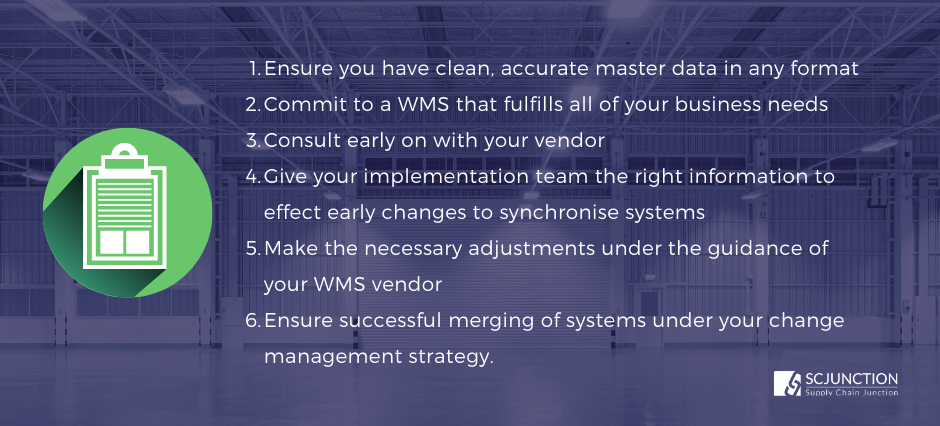MASTER DATA FOR WMS IMPLEMENTATION: A Step-by-Step Overview


A (supply) chain is only as strong as its weakest link. Don’t let it be your data.
Among the steps you are proactively taking to prepare for your WMS implementation, master data is one that cannot be ignored.
“Masterful master data requires the practice of defining and maintaining consistent definitions of business entities, then sharing them via integration techniques across multiple IT systems within an enterprise and sometimes beyond to partnering companies or customers.”
Philip Russom Ph.D. Industry Analyst
MANAGING MASTER DATA: WHY AND HOW
Because master data is used by multiple applications, an error in the data in one place can cause errors in all the applications that use it - like your WMS.
Master data and its integrity is the foundation of your automated business system, whether it is a WMS or any other transaction-centric application.
Your business cannot risk inefficiencies rooted in bad master data, like inconsistent data, which can cripple your WMS efficiency, lack of cross-domain relationships, reducing your ability to gain operational intelligence, or lack of process orchestration, making it difficult to manage and approve information in line with policies and processes.
You can overcome all these pain points by managing your master data as it synchronises all internal and external systems to keep your master data clean and consistent across the organization.
HOW TO IMPROVE AND PREPARE YOUR MASTER DATA FOR WMS IMPLEMENTATION
A strong data system entails 6 core disciplines which your company should instill and maintain as an ethos for ongoing excellent master data management.
The 6 core discipline of a strong data system:
- Governance: Directives that manage the organisational bodies, policies, principles and qualities to promote access to accurate and certified master data.
- Measurement: Measurement should look at data quality and continuous improvement.
- Organisation: Getting the right people in place - including master data owners, data stewards and those participating in governance.
- Policy: The requirements, policies and standards to which the MDM program should adhere.
- Process: Defined processes across the data life-cycle used to manage master data.
- Technology: The master data hub and any enabling technology.
ENSURING YOUR DATA AND YOUR WMS WORK TOGETHER, SEAMLESSLY
To prepare for a successful WMS implementation, you need several ducks in several rows.
1. Outline your business goals
Ensure your data management strategy will support you, whether you aim to improve your bottom line, beef up decision making, or more accurately cater to consumer trends.
2. Prioritise your data protection and security
Treat your data with the reverence of banks, insurance companies, and medical service providers. In the short-term, it will give you secure, accurate information. In the long run, it will ensure that any growth, expansion, or change to your services keeps the information secure and stored according to regulations, whatever you intend to use it for.
3. Focus on the quality of your data
Use only what is accurate and relevant to your business. Superfluous data may be good to have, or “nice to know”, but if it serves no real purpose, it’s taking up valuable space, processing power, and time that should be focused on the data that impacts your business. If you need to check this, use the data categories outlined at the start of this blog.
4. Keep it clean
Remove duplications, standardise the data capturing process and syntax, train your staff on the correct data-capturing procedures, and check the data regularly for accuracy and reliability.
5. Keep data accessible
This relies heavily on your data architecture, and the structures put in place by your data management team. Permissions and access will vary based on roles, and you need to stay on top of this to prevent sabotage, human error, inappropriate client contact, and uninformed changes to your master data. The teams who need it should have full access, and protected information must be kept that way.
6. Create a data recovery strategy
While having your data stored within secure servers or cloud applications may be a comforting thought, anything can happen to compromise those structures. Consider how you will back-up, restore, and recover your data if the worst happens.
7. Get a best-of-breed data management solution
A good data suite is one that can integrate and interface with your software solutions and give you the tools you need to satisfy your master data requirements.
It’s a lot of work to get your data to stand up against international best practices, but the more robust, accurate and structured your approach to master data management and its integrity, the higher your chances of success will be.
In our Master Data Masterclass, we look at the multiple ways in which you can ensure good quality master data within your warehouse, and further.
From here, you can begin rolling out the following phases / project assignments:
- Identify sources of master data
- Identify the producers and consumers of the master data
- Collect and analyse metadata for your master data
- Appoint data stewards
- Implement a data governance program and data governance council
- Develop the master data model
- Choose a tool-set
- Design the infrastructure
- Generate and test the master data
- Modify the producing and consuming systems
- Implement maintenance processes
KEEPING YOUR MASTER DATA CLEAN:
Collating and managing master data is a complex ongoing process. Like most things in software, the key to success is to implement master data management programme changes incrementally far ahead of any other additions, so that the business realises some short term benefits while the complete project remains a long-term process.

Much like with a WMS, no master data management can be successful without the support and participation of the business users; IT professionals do not have the domain knowledge to create and maintain high-quality master data.
Additionally, any project that does not include changes to the processes that create, maintain and validate master data is likely to fail.
Consult with SCJ for a full view of your warehouse requirements, data benchmarking, and pre-implementation tasks:
Browse our resources to get up to speed with the components of your WMS implementation that you'll need for a successful project, from start to finish:
TAGS
- WMS (51)
- Warehouse Best Practice (46)
- Implementing a WMS (29)
- Managing your warehouse (19)
- Omni Channel (18)
- eCommerce (18)
- Blog (16)
- Supply Chain Best Practice (16)
- Mid-Level (8)
- Customer Journey (7)
- Warehouse optimisation (7)
- General Tips (5)
- Industry General (5)
- Information (5)
- managing your Supply Chain (5)
- saudi arabia (5)
- Trends (4)
- smart warehouse (4)
- 3PL (3)
- News (3)
- ERP (2)
- Entry-level (2)
- ROI (2)
- Case Study (1)
- OMS (1)
- Picking (1)
- Press Release (1)
- Solution-Specific (1)
- Transport Management System (1)
Take A Look At The Results Of A Successful WMS Implementation.
See how Tarsus Distribution, in collaboration with SCJ boost overall efficiency by 60%






